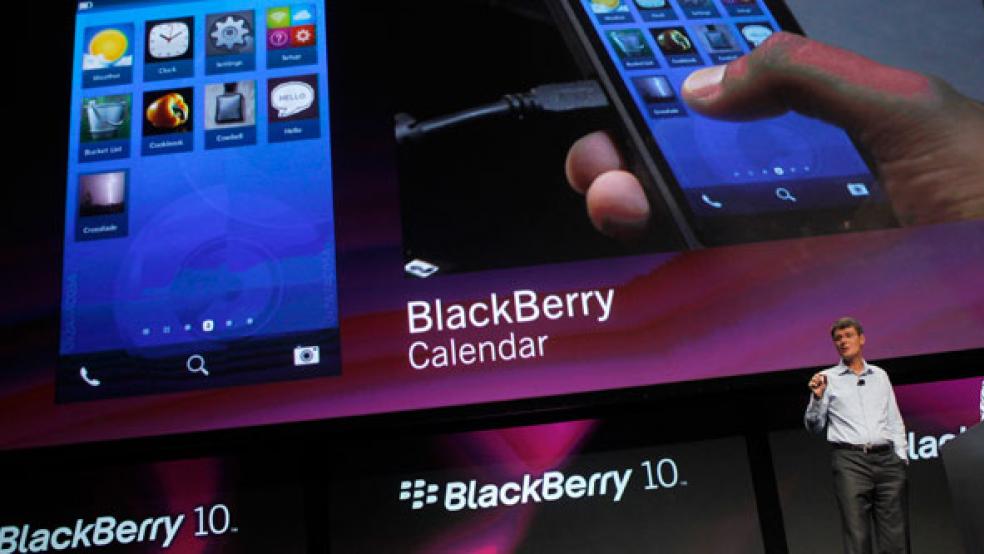Pssst… Looking for a bargain? Hurry to an electronics retailer like Best Buy, you may be able to snap up a BlackBerry Z10 for as little as $49. Amazon offered me one for a penny, as long as I agreed to sign a two-year contract with Verizon. And if you don’t want the shackles of a contract, you can still pick one up for $200 less than its $700 “official” price.

That’s hardly wonderful news for the recently renamed BlackBerry Ltd. (NASDAQ: BBRY), formerly known as Research in Motion, which is struggling to remain a viable competitor in an era that has seen smartphones using Google’s (NASDAQ: GOOG) Android system grow to 70 percent of the global market and more than 50 percent of the U.S. market. Ironically, in spite of the cut-throat competition between Android and Apple’s (NASDAQ: AAPL) iOS, this summer could still present BlackBerry with an opportunity, if it is in a position to capitalize on it. Apple’s next iPhone isn’t out yet, the Galaxy S-4 – announced to tremendous fanfare at Radio City Music Hall – has been available for a whole three months. There might be room for alternatives to capture some attention.
But BlackBerry seems likely to lose out yet again. True, the stock is trading at almost surreally cheap levels, at about half its book value and 0.4 times its trailing sales. Even Apple, in the wake of its fall from grace, looks expensive by comparison, commanding as it does nearly three times book value and 2.4 times trailing 12-month sales.
The problem? BlackBerry slapped a premium price on their new devices, which then failed to gain traction in the wake of their all-important launch date last March. Whether that is because some carriers were underwhelmed by the device or because BlackBerry’s marketing team fell down on the job, the bottom line is that the launch was a fizzle. Reports trickled in that there was no signage or special displays directing consumers’ attention to the new devices at AT&T and other carriers. Grilled at the company’s annual meeting last week, CEO Thorstein Heins dug in his heels defensively. “Were we perfect at the launch? Probably not. Was it a disaster? I don’t think so.”
New data from StatCounter showing that BlackBerry’s market share has climbed in recent days from less than 1.5 percent to about 4.4 percent might support that statement. Still, simply appealing to investors’ patience, as Heins did at the annual meeting, probably isn’t going to be enough. Nor does the company have the cash to go back to the drawing board and reinvent itself in hopes of finally delivering a serious competitive challenge to Apple and Samsung. As a device provider, BlackBerry is on the verge of fading into history.
Source: StatCounter Global Stats - Mobile Vendor Market Share
Does the same fate await Nokia (NYSE: NOK)? Like BlackBerry, it has struggled to remain relevant in the iPhone/Android tug of war, attempting to position its Lumia devices as a solid third way. And if there is room for one additional player in this bipolar smartphone universe, right now it is looking more as if it will be Nokia’s Lumia 1020 than the Z10. Nokia has largely wagered that better cameras and Microsoft’s software can help it stage a comeback. The Lumia 1020 boasts a camera with an astonishing 41 megapixels. Even if you’re a professional videographer, it’s hard to grumble about that.
There is still a lot of uncertainty surrounding Nokia, although it is trading at 5.9 times book value. The release of the company’s second-quarter earnings later this week will provide some additional data points, but it won’t give any insight into how the Lumia 1020 will play out with consumers once it becomes available later this month. Overall, though, Lumia sales have been climbing, and customer reviews on some websites are raves. Sure, it’s the Microsoft operating system, which a lot of potential buyers won’t love, and even the 1020 is heavier than Samsung’s Galaxy S4, which also offers a larger screen. Then there’s the “app gap”: the fact that Windows hasn’t been able to attract a compelling lineup of apps to offer Lumia users on their smartphones.
The question remains whether Nokia can convince consumers that all the bells and whistles it is offering make its new device as much of a premium product as, say, the iPhone. It’s an uphill battle: Apple has spent years branding the iPhone while both BlackBerry and Nokia tried to cruise along on their reputation as manufacturers of mobile phone communication devices, a notch below the slick design and innovative features pioneered by Apple. But the smartphone universe is changing. Chinese competitors are undermining the pricing power of both Apple and Samsung, meaning that premium prices will be harder to capture.
There are no guarantees that either BlackBerry or Nokia will be able to establish themselves as a viable third player in this market. But while BlackBerry is probably on its final last chance, with relatively few resources remaining to help its shrinking management team pull off a last-ditch turnaround, Nokia has the backing of Microsoft and a new device that is winning plaudits from at least some quarters.
Look for the showdown to continue this autumn and for most of the fireworks to be over by January, after the holiday shopping season. It will be a make-or-break period for BlackBerry. Nokia’s survival isn’t at stake in the same way, but if the Lumia 1020 can’t grab some market share from the incumbents and begin to chip away at whatever iPhone Apple launches later this year as well as the next generation of Android products, investors will walk away more rapidly than consumers.






